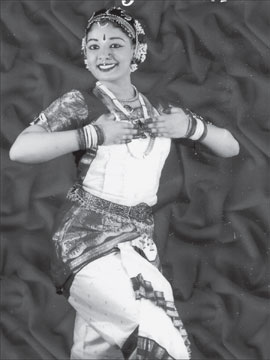Dance drama in modern theatre
By Subashini Pathmanathan
Dance Drama developed and penetrated into classical Bharatha Natyam
in the 20th century. From ancient times dance and drama were practised
together. Earlier there was no proper distinction between the two. The
Tamil classical dance is always considered as a divine art.
There are some who believe that dance evolved out of drama, while
some others believe that drama had its origin in dance. Anyway, dance
and drama emerged together to attract common people in the 20th century.
The relationship between the two is very close and almost
inseparable. Earlier dance and drama were known as Koothu.
|

A scene from a dance drama |
An ancient Tamil classic Koothanool says, Koothil peranthathu Natya
kope Natyam peranthathu Nadaka wahaiye (Dance had its origin in drama
and drama had its origin in dance).
In the past male dancers were known as Koothar and female dancers as
Kuthiyar. Even the cosmic dancer Lord Nataraja is called Kuthapiran,
Ampalak Kuhan, Thirukuthan, Kootharasan and Thillai Kuthan.
Tamil classic Silapathikaram of the 2nd century AD, deals with a
variety of Kuthus. During the Pallava times,drama held a pre-eminent
position. Even the Pallava king Mahendera Varman is credited with having
written a dance drama Matha Villasam. During this period, dance and
drama flourished in temples and their environs. After the Pallava
period, dance and drama were patronised by the Chola kings who also
supported the arts, artistes and encouraged various other art forms
including sculpture, craftwork and painting
Stone inscriptions
This is evidenced by various stone inscriptions, copper plate
inscriptions and literary works. The Chola kings endowed villages to the
dancers. To this day, there is a village called Kootha Nallur which was
endowed on dancers. In the 17th century, Bhagavatha Mela, Pallu, and
Kuravanchi began to appear in the drama scene and soon these were
combined with dance and assumed the shape of dance drama.
In the course of the 17th century there was a gradual separation of
dance and drama.
In the 18th and 19th centuries dance faced a setback while drama
gained recognition and popularity. In the early 20th century, cinema
with its new techniques acquired a pre eminent position at the expense
of drama which was pushed back to the verge of extinction.
This was the period when drama stars of the theatre blossomed into
cinema stars and drama halls were transformed into cinema studios. After
a brief period of oblivion dance then known as Sadir, blossomed into
Bharatha Natyam.
After 1940, Bharatha Natya dance teachers and Bharatha Natya
institutions choreographed dance drama for epics. The first dance drama
was Kutrala Kuravachi presented by Srimathi Rukmani Devi of Kalashetra.
Whatever it may be, it is more or less based on drama than dance.
Themes
It was followed by several others. After 1962 dance dramas were
presented on several themes even on fiction works. In the last decade of
the 20th century, teledance drama emerged and featured in TV channels.
This was a new innovation and acquired a unique position with the aid of
lighting and sound techniques. This partakes more of cinema than stage
dance drama.
Though dance drama has much in common with dance there are essential
differences between the two. Bharatha Natyam, for instance has a
repertoire of its own.Bharatha Natyam with its exquisite combination of
Adavus, Abhinaya, Bavas Rasas, eye movements, neck movements, and hand
madras (gestures) is essentially an individual dance.
Bharatha Natyam is totally based on classical Carnatic music base
while in dance drama the repertoire is set then and there based on the
story of the dance drama portrays.
For dance drama the music is not necessarily confined to the
traditional Carnatic music. In dance dramas a variety of musical
instruments are used to enhance the effect and beauty of the scene.
But in Bharatha Natyam the use of musical instruments are limited and
strongly adhered to the tradition. However, for Bharatha Natyma the
stage is set once and for all while in dance drama the stage has to be
rearranged according to the scene portrayed.
Generally, in dance drama the costumes, the make-up and hair dressing
are adopted to each character's needs and necessity, while Bharatha
Natyam uses only certain designed costumes and one distinctive make up.
Dance drama is considered as Bharatha Natyam by laymen because dance
drama are presented through the idiom and grammar of Bharatha Natyam. |


